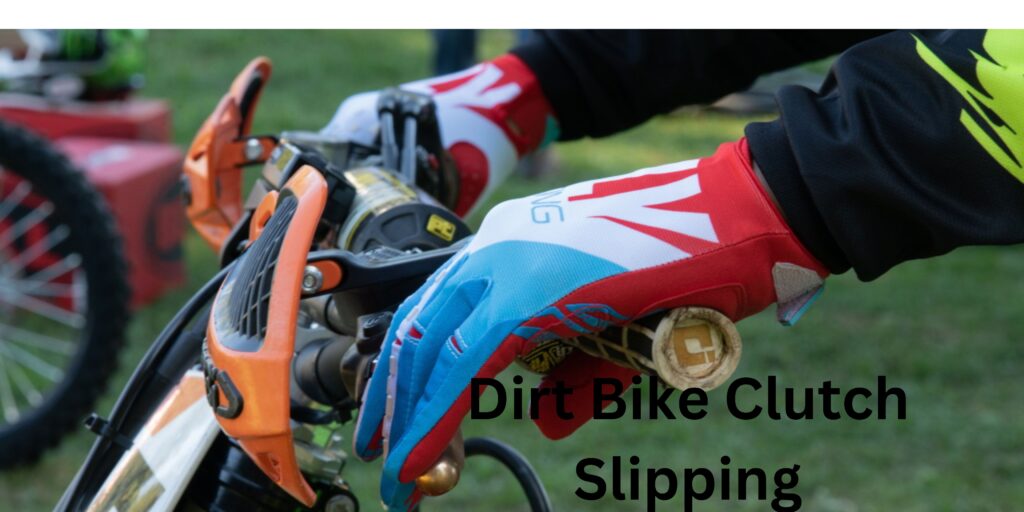Introduction
If you ride a dirt bike, you know how important the clutch is. It lets you manage speed, power, and traction. When the clutch slips, a fun ride can turn frustrating fast. I have faced this issue myself, and I know how confusing it can be to diagnose and fix.
In this guide, I’ll explain dirt bike clutch slipping. We’ll cover symptoms, causes, and simple fixes. By the end, you’ll understand what’s wrong with your bike and how to fix it before it worsens.

What Are the Symptoms of a Slipping Clutch?
The first step in solving any problem is recognizing the symptoms. A slipping clutch on a dirt bike often shows these signs:
Loss of Power – The engine revs high, but the bike doesn’t accelerate as it should.
Delayed Response – When you twist the throttle, you’ll notice a delay in power delivery.
Burning Smell – A strong burnt friction plate smell coming from the clutch.
Difficulty in Clutch Engagement – The clutch lever feels odd, so engaging gears smoothly is tough.
Overheating Issues – Your clutch plates may overheat, which makes them less effective.
High RPM Without Speed Increase – The engine sounds like it’s working hard, but the bike isn’t moving faster.
If you notice one or more of these symptoms, it’s time to check your clutch before it worsens.
Common Causes of Dirt Bike Clutch Slipping
A slipping clutch doesn’t happen out of nowhere. There are several possible causes:
- Worn-Out Clutch Plates
Over time, the friction plates wear down due to constant use. This reduces their ability to grip, causing slippage.
- Incorrect Clutch Cable Adjustment
If the clutch cable is too tight, the clutch may not fully engage, leading to slipping.
- Oil Contamination
Using the wrong type of oil or contamination from dirt and debris can cause the clutch plates to slip.
- Weak Clutch Springs
Clutch springs lose tension over time. If they are too weak, they won’t press the clutch plates together firmly, leading to slippage.
- Overheating from Heavy Use
Riding in tough conditions or using the clutch too much, like slipping it on tricky terrain, can overheat and harm the plates.
- Aftermarket or Low-Quality Parts
Using cheap or wrong aftermarket clutch parts can lead to slippage. They might not fit well or handle stress properly.
FAQs (Frequently asked question)
How do I know if my clutch is slipping?
If your engine revs increase but your bike doesn’t accelerate properly, your clutch is likely slipping.
Can I fix a slipping clutch myself?
Yes, basic fixes like adjusting the clutch cable or changing the oil are easy to do. However, replacing clutch plates may require mechanical experience.
What happens if I ignore a slipping clutch?
Ignoring the issue can lead to further damage to the clutch, gearbox, and overall bike performance.
How often should I replace my dirt bike clutch plates?
It depends on usage, but typically every 20-50 hours of riding for high-performance bikes.
Does using the wrong oil cause clutch slipping?
Yes, oils not meant for motorcycles can make the clutch too slippery. This reduces the clutch’s ability to engage. properly.
How to Fix a Slipping Clutch
Once you have identified the cause, fixing the problem becomes easier. Here are some solutions:
- Replace Worn-Out Clutch Plates
If your friction plates are worn, replacing them with a good set can fix clutch function.
- Adjust the Clutch Cable
A quick adjustment can sometimes fix the issue. Make sure there is some free play in the lever to avoid unnecessary pressure on the clutch.
- Use the Right Oil
Always use oil recommended for wet clutches in dirt bikes. Regular automotive oils can be too slippery and cause clutch slippage.
- Upgrade Clutch Springs
If your clutch springs are weak, stiffer springs can help. They improve engagement and stop slippage.
- Avoid Overheating the Clutch
Try not to overuse the clutch while riding. Letting it cool down between rides can prevent overheating issues.
Read more:
- Dirt Bike Financing: Everything You Need to Know
- Shocking Truth: Where to Find the Cheapest Used Dirt Bikes in 2025″
- Use OEM or High-Quality Aftermarket Parts
Cheap parts may not last long. Investing in original or high-quality aftermarket clutch kits ensures longevity and better performance.
Pros and Cons of Fixing Clutch Slippage Early
Pros:
Restores proper power delivery
Prevents further damage to the transmission
Saves money in the long run by avoiding major repairs
Improves overall riding experience
Cons:
Requires time and effort to diagnose the issue
Some fixes can be expensive
Improper installation can cause additional problems
User Reviews and Ratings of Common Clutch Fixes
Here’s a summary of rider experiences and forum reviews on common fixes. This shows how effective and easy they are to install:
Clutch plate replacement: Effectiveness: 9/10 Ease of Installation: Moderate Average Cost: $100 – $200
Clutch cable adjustment: Effectiveness: 7/10 Ease of Installation: Easy Average Cost: Free – $20
Using correct oil: Effectiveness: 8/10 Ease of Installation: Very easy Average Cost: $10 – $40
Upgrading clutch springs: Effectiveness: 8/10 Ease of Installation: Moderate Average Cost: $50 – $100
Avoiding Overheating:
Effectiveness: 6/10
Ease of Installation: Varies by riding style
Average Cost: Free
Conclusion
A slipping dirt bike clutch can ruin your ride, but diagnosing and fixing it isn’t too hard if you know what to look for. I’ve dealt with clutch slippage a few times, and learning how to fix it myself saved me a lot of money and trouble.
The best approach is to address the issue early.Fixing the clutch cable, replacing worn plates, or choosing the right oil can help. Acting fast will stop bigger issues later on.
